Visit the oratories
Visit the 18 oratories in the village of Eyguières, some of which are privately owned.
Duration: 2 hours for oratories located in the village
Allow an extra 2 hours for the other oratories
Estimated times are given for pedestrian travel.
Only crosses and oratories located on public land are identified on the map.
Saint Joseph's Oratory
Built thanks to the generosity of the family of Senator Jean-Marie Bayol, Saint-Joseph's oratory stands at the corner of rue des Frères mineurs and route de Sénas.
This oratory was rebuilt almost identically, but using modern materials, in 1984 after the original was destroyed by a vehicle. All that remains of the old oratory is the wrought-iron cross. The statue of the saint is housed in a semicircular niche.
We took advantage of the reconstruction to move it slightly for its safety.
A few words about Saint Joseph: Saint Joseph was the head of the Holy Family. He took care of everything necessary for the Virgin Mary and Jesus. He is therefore the patron saint of families, fathers, craftsmen, workers and the dying (he died surrounded by Christ and the Blessed Virgin).
Many Catholics entrust their material affairs to his prayers: a job search, an apartment search....
Moreover, because he was a just man, many Catholics ask for his intercession to discern their vocation, to find the right husband, the right wife...
St. Joseph is celebrated on March 19. His feast day was very popular with craftsmen (he was a carpenter) and then with workers (for the latter, within the limits of their availability).
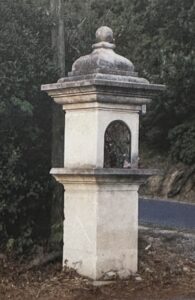
Saint Mark's Oratory
Regrettably, the base was made of modern materials when the oratory was moved following a road accident that damaged it. The ashlar shaft has been strengthened and enlarged, the niche is arched and the slightly rounded roof placed on a cornice, all topped by a wrought-iron cross.
This cross once stood on Place de la Croix, now Place Thiers.
This oratory was erected by the Brotherhood of Winegrowers and Cultivators.
In days gone by, people would stop here on the day of the April 25 procession, on their way back from mass celebrated in the Saint-Pierre-de-Vence chapel.
This tradition continues to this day, with the blessing of the fields, crops and herds, and the traditional meal of cabri and alfalfa omelette (2-2-3).
A few words about Saint-Marc, Sant-Marc in Provençal: Saint-Marc is depicted holding a book in his left hand and a feather in his right. A lion sits at his feet.
Saint Mark, evangelist disciple of the apostles Peter and Paul, came by boat to evangelize the Po Valley region of Italy.
He was shipwrecked in the lagoon that would later, in 452, give birth to Venice.
Captured and tortured in Alexandria, Egypt, he died a martyr in the year 60.
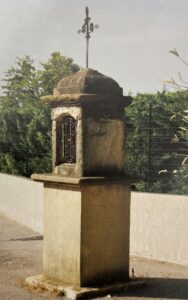
Saint-Symphorien Oratory
The oratory features a slender square shaft, an arched niche and a cornice. The slightly pyramidal roof would have held a cross. The niche houses a statue of the saint, with his head resting in his hand.
It was erected during the 1883 mission.
The date engraved on the base commemorates this mission, as well as Gaspard REY, Eyguières parish priest from 1872 to 1892, and Léopold Roquebrune, curate from 1881 to 1885.
A few words about Saint-Symphorien, Sant-Sifourian in Provençal: a native of Autun, Symphorien was martyred around the year 180, probably under Marcus Aurelius. Having refused to worship the emperor, he was beheaded in his twentieth year.
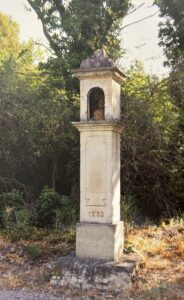
Saint-Anne's Oratory
The square base is made of several blocks of stone, while the shaft is of saffron stone. A niche protected by a wrought-iron grille houses a statue of the saint.
The domed roof and cornice are also in saffron stone.
A wrought-iron cross crowned the whole. The cross, which fell during bad weather, has been returned to the archaeological repository, pending restoration of the oratory in the near future.
The chapel of the Récollets convent was dedicated to Sainte-Anne. On their way to the Sèti cross to the north of the village, the Récollets' Friars Minor would pass by Chemin Sainte-Anne, in front of the oratory, and then take the path that has kept their name, Chemin des Frères mineurs.
A few words about Sainte-Anne, Santo-Ano in Provençal :
Presented as the mother of the Virgin Mary and therefore the grandmother of Jesus, it wasn't until 1854 that her solemn feast and cult became official.
Sainte-Anne is often depicted with her daughter Marie in her arms, or teaching her to read.
She is the patron saint of many trades, including carpenters, cabinetmakers, housewives and lacemakers.
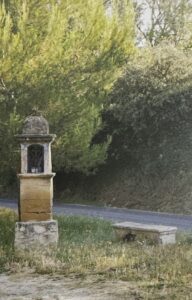
Saint Peter's Oratory
This slender, sober oratory, built of Crau pebbles of various shapes and colors, consists solely of a base and a shaft. The niche contains a statue of Saint-Pierre, made by an Eyguièren santonnier.
A beautiful wrought-iron cross crowns the small, rounded pebble roof, set on a cornice that is a simple row of tiles.
It was erected on the initiative of three members of the Escolo Felibrenco de la Crau and blessed on April 25, 1953 by Abbé Bucelle, parish priest of Eyguières.
Even today, on the feast of Saint-Marc (April 25), a procession takes place to the oratory in memory of the period when mass was said every Sunday in the nearby chapel of Saint-Pierre-de-Vence. The tradition of ending the procession with a meal of cabri and alfalfa omelette dates back to 1838, when a group of literati gathered for Saint-Marc's Day and sang verses first in French and then in Provençal during the meal. This feast, "La riboto doù cabrit", marked the birth of the Eyguiéren félibrige in 1869, and it was in a room in the mas de Saint-Pierre-de-Vence that the cabri meal was held for many years.
A few words about Saint-Pierre, Sant Pèire in Provençal :
An apostle from Galilee, he announced Christ's resurrection to the Jews, baptized the first converts and died in Rome in 64. The Vatican Basilica will be built over his tomb. Depicted as an old man, he holds in his hand either a scroll, a key or a bunch of keys.
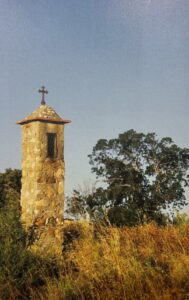
Saint-Gens Oratory
The oratory consists of a square ashlar pillar topped by a semicircular niche on an overhanging cornice. The pyramidal roof has no cross.
Located in a vineyard, the oratory was erected by the Salen family. The inscriptions "Reconnaissance à saint Gens 1833 1906 RS" are inscribed on the shaft of the monument.
A few words about Saint-Gens, Sant-Gent in Provençal: written documents and oral tradition place Gens' short life at the beginning of the 12th century.
Born in Monteux, in the diocese of Carpentras, he left his family and his village, still in his teens, to live as a hermit in the solitude of a wild valley near Le Beaucet. Legend has it that he caused two springs to gush forth from a rock.
He died on May 16, 1127, and his body was buried in a rock near which a Romanesque chapel was built in the mid-12th century.
Supported by popular fervor and numerous miracles, his cult is approved by the Church. He is invoked to obtain rain in times of great drought.
Today, as in centuries past, her pilgrimage is one of the most popular in the whole Provence region.
Saint-Gens was also implored to protect us from fevers.
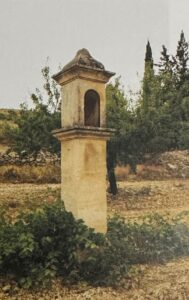
Notre Dame de la Ferme du Moulin Oratory
The Notre-Dame oratory is one of Eyguières' most beautiful oratories, with its four-sided open niche; the four-sloped roof was topped by a stone ball. A monogram is carved on the pediment.
Erected in the early 19th® century by the Marquis de Benault de Lubières, the oratory is now owned by the de Becdelièvre family.
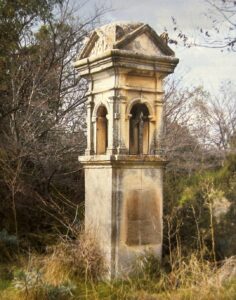
Saint-Véran Oratory
No longer in existence, it stood on avenue Saint-Véran. It was erected by the Saint-Véran brotherhood.
Constructed of highly friable saffron stone, the base supported a low-arched niche on a massive cornice. The pyramidal roof, also on a cornice, was topped by a wrought-iron cross. (Description by Pirigoin, Association nationale des amis des oratoires).
The oratory has been destroyed by erosion and successive impacts from various vehicles.
The wrought-iron cross has been recovered and is now part of the municipal heritage collection at the Centre d'études archéologiques.
A few words about Saint-Véran, patron saint of transhumant shepherds:
Véran (or Vrain), a hermit in Vaucluse', was chosen bishop of Cavaillon towards the end of the 6th century. He took part in the Council of Macon in 585. He died of the plague on November 13, around 590, in the city of Arles.
He healed the sick with the sign of the cross, but it was at Fontaine-de-Vaucluse that he performed his most famous miracle. Using the sign of the cross, he rid the Sorgue of a "dragon", called Couloubre, which was devouring sheep.
Located in a vineyard, the oratory was erected by the Salen family. The inscriptions "Reconnaissance à saint Gens 1833 1906 RS" are inscribed on the shaft of the monument.
A few words about Saint-Gens, Sant-Gent in Provençal: written documents and oral tradition place Gens' short life at the beginning of the 12th century.
Born in Monteux, in the diocese of Carpentras, he left his family and his village, still in his teens, to live as a hermit in the solitude of a wild valley near Le Beaucet. Legend has it that he caused two springs to gush forth from a rock.
He died on May 16, 1127, and his body was buried in a rock near which a Romanesque chapel was built in the mid-12th century.
Supported by popular fervor and numerous miracles, his cult is approved by the Church. He is invoked to obtain rain in times of great drought.
Today, as in centuries past, her pilgrimage is one of the most popular in the whole Provence region.
Saint-Gens was also implored to protect us from fevers.
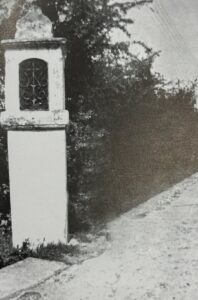
The sèti' cross
The origin of this monument predates the French Revolution, as the Récollets' Friars Minor used to visit it on their walks.
The current wrought-iron cross is not original.
Following its destruction by lightning in 1990, it was rebuilt by Mr. Jauffret, a wrought-iron craftsman from Eyguières. The whitewashed shaft was rebuilt on its original millstone base.
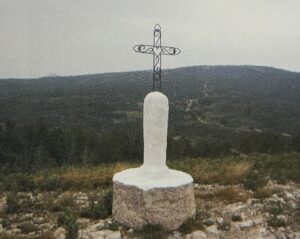
La croix du Moulin
This cross stands at the entrance to the Mas du Moulin, owned by the de Becdelièvre family.
The first cross was erected in 1826 on the occasion of a jubilee.
Monsieur de Bonnecorse, who owned the property at the time, replaced it in 189o with this now badly deteriorated cross, originally bearing a magnificent metal Christ from the foundry of the Ecole des Arts et Métiers in Aix-en-Provence. Unfortunately, this Christ was stolen around 1979.
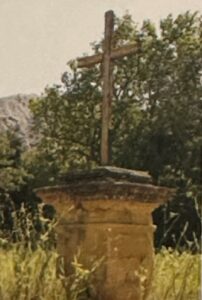
The Roquemartine cross
A beautiful wrought-iron cross used to stand in the driveway leading to the Château de Roquemartine. This cross was replaced by Monsieur de Bonnecorse in 1898.
The ceremony took place at the same time as the installation of the new cross at Mas du Moulin.
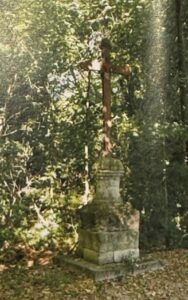
The Swallow Cross
During the mission® preached by Eugène de Mazenod, priest superior of the Provence missions, from February 14 to March 25 1819, the Hirondelle cross was erected on the path leading to the Bormes fountain.
This wrought-iron cross stands on a stone pedestal.
In 1851, when the new Salon road was built, the cross was transferred to the faubourg de l'Hirondelle, near the Canal des Garrigues, where it stands today.
But the proximity of the canal is detrimental to the monument, as silt extracted from the canal is washed up against the pedestal.
In 1896,n local residents made donations to restore the base of the building, consolidate the pedestal, surround it with a protective wall and make it accessible via a staircase. These three dates appear on the monument.
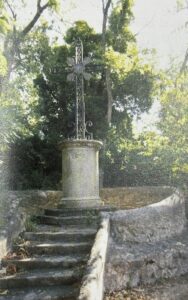
The cross of rest
Originally, a small iron cross, placed on a pedestal, was intended to mark the halt of funeral processions on their way to the cemetery.
Moved twice and badly damaged, the cross was replaced by a new structure, thanks to the generosity of Camille Monier.
The new monument was blessed on November 3, 1895, the day of Camille Monier's funeral.
The old cross, known as the "croix des Aires", is currently located in the cemetery near the Saint-Vérédème chapel (2-2-2).
At funerals, the procession stopped at the Repos cross. Only those close to the deceased would go as far as the cemetery.
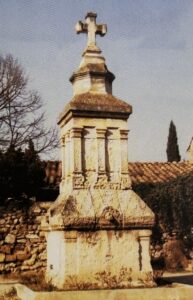
The Bel-Air cross
Originally, a small iron cross, placed on a pedestal, was intended to mark the halt of funeral processions on their way to the cemetery.
Moved twice and badly damaged, the cross was replaced by a new structure, thanks to the generosity of Camille Monier.
The new monument was blessed on November 3, 1895, the day of Camille Monier's funeral.
The old cross, known as the "croix des Aires", is currently located in the cemetery near the Saint-Vérédème chapel (2-2-2).
At funerals, the procession stopped at the Repos cross. Only those close to the deceased would go as far as the cemetery.
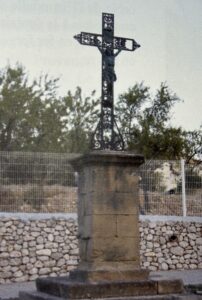
The Cemetery Cross
The first cross stands in the landscaped cemetery of Eyguières, amid tall yew trees.
To commemorate the expansion of the cemetery, decided under the mandate of Frédéric Monier (1842-1908), this beautiful cross was erected in one of the cemetery's alleys.
The cemetery was inaugurated on November 1, 1878. On the same day, the ashes of Pierre Joseph François Benoit, mayor of Eyguières, who died on January 26, 1842, were transferred to the same cemetery.
The base and shaft, topped by a wrought-iron cross, are made of tuff. Various inscriptions can be seen on either side of the shaft:
- The date of the cemetery extension and the names of the mayor and deputy mayors at the time
- A reminder of the transfer of Pierre's ashes
Joseph François Benoit
- HODIE MIHI CRAS TIBI
- List of council members
On the heights of the cemetery, opposite the Saint-Vérédème chapel, stands a second iron cross. This cross is the former "croix du Repos", known as the "croix des Aires".
The stone base is said to be that of the cross in the village square (Place Thiers), which today stands on the Saint-Marc oratory.
A project to restore and relocate the cross is under study.
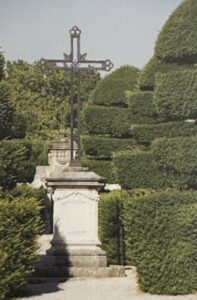
Calvary crosses
Originally, the three crosses of Calvary represented Christ and the two thieves.
Located on the "Cousa'", they were blessed on October 14, 1537 by the Bishop of Avignon. At the same time as the Calvary, a chapel of the Holy Cross was planned.
The town has taken out a loan from the residents of Eyguières to contribute to these expenses:
"Emprunt prest pour la ville deguières pour ayder à fayre la chapelle de la Sainte Croix et ---mont calvayre posé sus la montanhe sus le cousac terrayre d'aquest luoc deguières, trois croyes la croye de Jésus Christ, la croye du bon larron et la croye du mauvais larron.
..Monsieur Belli promising to build the said chapel as follows.....".
We don't know whether the chapel was actually built or restored.
In 1848, the crosses on the calvary were restored during a mission. A further restoration took place in the 1920s, when Christ was surrounded by two statuettes. In the 1970s, the crucifix was replaced by a simple stone cross.
In 1986, lightning mutilated part of the Calvary, completely destroying one of the statues.
The commune then decided to completely rebuild the Calvary. The three wooden crosses and stone Christ recall the original monument.
The new Calvary was blessed on September 18, 1988 by Vicar General Monsignor Plano.
The Sainte-Croix chapel could be located below the summit of the hill, where there's a very old building with some astonishing features: this building is oriented, i.e. it develops along an east-west axis, as required by church construction standards in medieval times.
In the eastern part of the building, the remains of a cul-de-sac apse are clearly visible, extending well beyond the general masonry of the building. This can only correspond to the choir of a church or chapel from the Romanesque period, and in one of the rooms, a large fragment of a column shaft can still be seen in the masonry.
But only an excavation campaign could certify the presence of the Holy Cross chapel.
The mountain or hill of Calvaire was used as a stone quarry until 1910. The quarry provided work for a number of foreigners, mainly Italians. The job of the stone-breakers consisted of using a small hammer fitted with a long shaft to produce chips of roughly equal size, which were used for road construction.
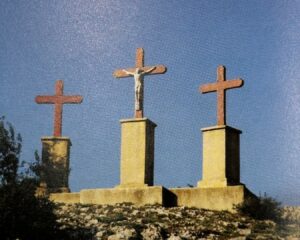
The Glauges cross
The earliest known mission preaching linked to this cross was in April 1704.
It was given by priests from Avignon and lasted 27 days.
The original wooden cross planted on the path has now been replaced by a sober, elegant iron cross atop an octagonal column of Verdelet stone. It was at the foot of this cross that Revolutionary Commissioner Bruyère was murdered during the Col de Mélet affair.
The station was used on April 25, St. Mark's Day, for the blessing of the fields.
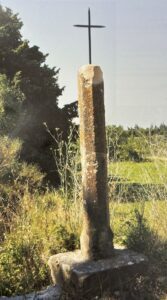
Monument de la Vierge
Facing south, mounted on a pedestal, the cast-iron statue is painted in Mary's colors.
The Virgin's foot crushes a snake, symbolizing the devil.
The face of the pedestal, facing away from the sun, bears the inscription:
"Mater divinae gratiae, ora pro nobis"
The one on the east shows the names of the preachers and the date of the mission.
It reads:
At noon a quatrain by Ch. De Bonnecorse:
"From the gabins to the Alpines, O you we cherish
Blessed by your divine hands
Our homes and our harvests".
To the north, the Provençal verses of Monsieur le Chanoine Milic :
If water "makes you pretty",
Your graces make souls beautiful
Spread them, O our Lady Over your joyful people
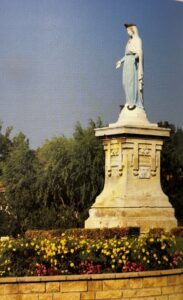
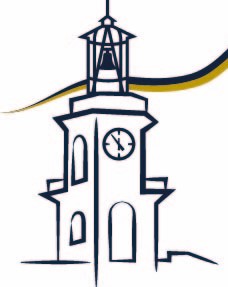
Welcome to the digital website of the Eyguières tourist office.
Only one place to accompany you during your stay.
This site was developed by the association Agir Ensemble Pour Eyguières.
Let's stay connected
Sign up for our newsletter to stay informed of our news and alerts.
